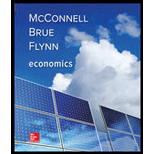
Sub part (a):
Accounting and economic profit before and after the tax.
Sub part (a):
Answer to Problem 5P
Total explicit cost is $220,000: Accounting profit with low income is -$20,000 and with high profit is $180,000.
Explanation of Solution
Current earning per worker is $60,000. She would prefer to become an entrepreneur unless she earns an accounting profit of at least $60,000. As an entrepreneur, she is planning to open a small grocery store. She has an annual cost of $150,000 for labor, $40,000 for rent and $30,000 for equipments.
There is a one-half probability that the revenue equals to $200,000 (low revenue) and one-half probability that revenue equals to $400,000.
Total explicit cost can be calculated as follows.
Total explicit cost is $220,000.
Accounting profit with low revenue can be calculated as follows.
Accounting profit with low income is -$20.000.
Accounting profit with low revenue can be calculated as follows.
Accounting profit with high income is $180.000.
Concept introduction:
Accounting profit: Accounting profit refers to the excess revenue after subtracting the total cost from the total revenue.
Economic profit: Economic profit refers to the additional profit after subtracting the
Sub part (b):
Expected average revenue, Accounting profit and economic profit.
Sub part (b):
Answer to Problem 5P
Expected average revenue is $300,000: Accounting profit is $80,000 and Economic profit is $20,000.
Explanation of Solution
Expected average revenue can be calculated as follows
Expected average revenue is $300,000.
Expected accounting profit can be calculated as follows.
Expected accounting profit is $80,000.
Expected economic profit can be calculated as follows.
Expected economic profit is $20,000. The person would quit the job since there is a positive economic profit.
Sub part (c):
Accounting profit after tax, and expected profit.
Sub part (c):
Answer to Problem 5P
Accounting profit after tax is $135,000: Expected profit is $57,500 and -$2,500.
Explanation of Solution
There is an accounting loss with the low income. Thus, the accounting profit with the low income does not change.
Accounting profit with high income after tax can be calculated as follows.
Accounting profit after tax is $135,000.
Expected accounting profit after tax can be calculated as follows.
Expected accounting profit is $57,500.
Expected economic profit after tax can be calculated as follows.
Expected economic profit is -$2,500. Since the expected economic profit is negative, the person would not quit the job.
Sub part (d):
Whether the individual is indifferent or not between Accounting profit after tax and current earnings.
Sub part (d):
Explanation of Solution
The accounting profit after tax in case of average revenue is $60,000, which is equal to the current earnings. Therefore, she is indifferent about her decision to quit the job or not. So, some people would prefer to go for entrepreneurship and other will stay as workers.
Want to see more full solutions like this?
Chapter 18 Solutions
Economics (Irwin Economics)
- Explain how much of emotional, mental and physical toll makes it so difficult to break the cycle of poverty.arrow_forwardCase Study: The Impact of Ebola on Tax Revenue in the DRC Background: The Democratic Republic of the Congo has experienced mulitiple outbreaks, with the 2018-2020 outbreak being one of the most severe. The outbreak had profound effects on public health, the economy and government operations. The DRC's economy already fragile due to policital instability and conflict, faced additional stain as the Ebola virus spread across several provinces. Economic disruption: The Ebola outbreak led to significant disruptions in the affected regions. Businesses were forced to close or reduce operations due to quarantine measures and the fear of contagion. this resulted in a sharp decline in economic activities, particularly in sectors such as agriculute, mining and trade. reduced consumer spending and interruptions in supply chains further exacerbated the economic downturn. Impact on Tax Revenue: the economic…arrow_forwardKey shortcomings of the Human Capital approach to measuring the monetary value of benefits of new treatments are that it Will generate lower benefits for male lives on average Will generate higher benefits for female lives on average Will tend to OVERVALUE improvements in quality of life Will tend to UNDERVALUE improved survival for people out of labour forcearrow_forward
- One of the key concepts in economics that underpins the necessity of making tough choices and confronting difficult tradeoffs through some form of collective decision-making is called Production Consumption Exchange Equity Scarcityarrow_forwardAllocative efficiency WITHIN the health care sector refers to What mix of nonmedical and medical goods and services should be produced in the macro-economy What mix of medical goods and services should be produced in the health economy What specific health care resources should be used to produce the chosen medical goods and services Who should receive the medical goods and services that are producedarrow_forwardProduction efficiency is most concerned with Choice of inputs in production process Quantity of outputs resulting from the production process The technological process of production All of the abovearrow_forward
- Choose all of the following that are assumed to be constant while constructing the production possibilities curve Technology Precise mix of inputs Institutional arrangements like judicial protection of business contracts Outputsarrow_forwardA point that lies OUTSIDE of the PPC can be achieved if A major technological innovation increases production efficiency A sudden influx of resources e.g., massive immigration of trained nurses Economic reform resulting in greater protection of intellectual property rights All of the above Only options 1 and 2arrow_forwardThe marginal benefit from each successive unit of medical care consumed declines BECAUSE each successive unit is more expensive to produce True Falsearrow_forward
 Managerial Economics: A Problem Solving ApproachEconomicsISBN:9781337106665Author:Luke M. Froeb, Brian T. McCann, Michael R. Ward, Mike ShorPublisher:Cengage Learning
Managerial Economics: A Problem Solving ApproachEconomicsISBN:9781337106665Author:Luke M. Froeb, Brian T. McCann, Michael R. Ward, Mike ShorPublisher:Cengage Learning Managerial Economics: Applications, Strategies an...EconomicsISBN:9781305506381Author:James R. McGuigan, R. Charles Moyer, Frederick H.deB. HarrisPublisher:Cengage Learning
Managerial Economics: Applications, Strategies an...EconomicsISBN:9781305506381Author:James R. McGuigan, R. Charles Moyer, Frederick H.deB. HarrisPublisher:Cengage Learning Economics (MindTap Course List)EconomicsISBN:9781337617383Author:Roger A. ArnoldPublisher:Cengage Learning
Economics (MindTap Course List)EconomicsISBN:9781337617383Author:Roger A. ArnoldPublisher:Cengage Learning







